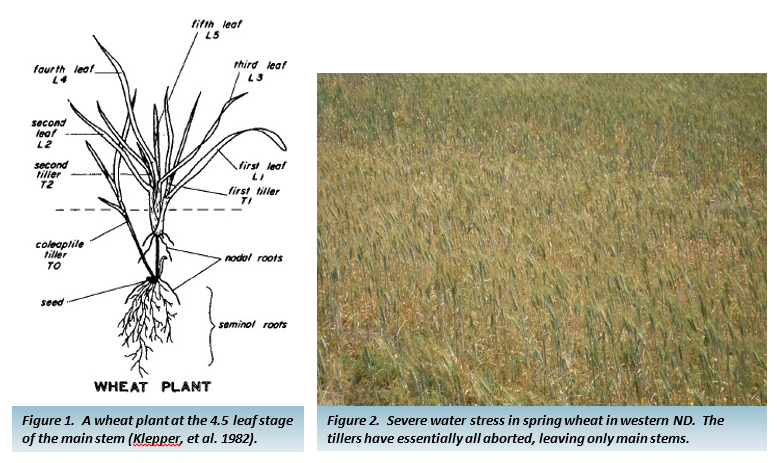How Heat and Water Stress Effects Wheat Plants in Vegetative Stages
This page was adapted from the article, "How Heat and Water Stress Effects Wheat Plants in Vegetative Stages," which appeared in Crop & Pest Report on June 10, 2021.
The first half of June is normally a cool, wet period in North Dakota, perfect for the development of tillers and adventitious (crown) roots in spring wheat. Sadly, this is not the case in 2021. What are the effects of heat and water stress in spring wheat during vegetative stages of growth?
A spring wheat plant consists of a main stem (what pushes out of the ground), and a variable number of tillers. The two most important tillers with regards to yield are the T1 tiller and the T2 tiller, which come from the base of the first and second leaves on the main stem (see Figure 1). The T1 tiller is initiated, or not, at the 2.5 leaf stage of the main stem, and the T2 tiller is initiated, or not, at the 3.5 leaf stage of the main stem. Normally, the lack of initiation of T1 or T2 tillers is related to a lack of nitrogen or phosphorus. It is rare, based on my 40 years of observation, for heat and water stress to interfere with T1 and T2 tiller initiation, although I did observe it in 1988.
Not obvious to the naked eye, however, are the "decisions" that the spring wheat plant makes between the 4 and 6 leaf stages of the main stem. The growing point of a wheat stem can produce leaves or spikelets. The number of leaves, and the number of spikelets on each stem, are affected by environment, and are "decided" between, roughly, the 4 and 6 leaf stage of the main stem. Heat and water stress between the 4-6 leaf stages of the main stem can cause the plants to go into what I call a "7-leaf habit," and the number of spikelets on the main stem will be reduced. Normally, most hard red spring wheat varieties produce 8 leaves on the main stem. That is, the flag leaf on the main stem is the 8th leaf on the main stem. However, heat and water stress can "rush" this process, and 7-leaf plants will occur.
7-leaf plants are invariably less productive than 8-leaf plants, because the same heat and water stress will also cause the plants to have fewer spikelets. In short, the heat and water stress we are now experiencing can cause spring wheat plants to have a 7-leaf habit. Also, head size will be reduced with either a 7 or 8-leaf habit. So, even if rainfall is plentiful the rest of the growing season, this current heat spell will reduce yield of plants currently in the 4-6 leaf stage of the main stem.
Some of the earlier-seeded spring wheat is past the 6-leaf stage, and will not be as affected with regards to head size and leaf number. However, if the drought continues, the plants will continue to adjust to the poor growing conditions, by shedding, or aborting, tillers. Eventually, if the drought is prolonged and severe enough, only main stems will remain, and the yield will be very low, as shown below (Figure 2).

R. Jay Goos
Soil Science Professor
